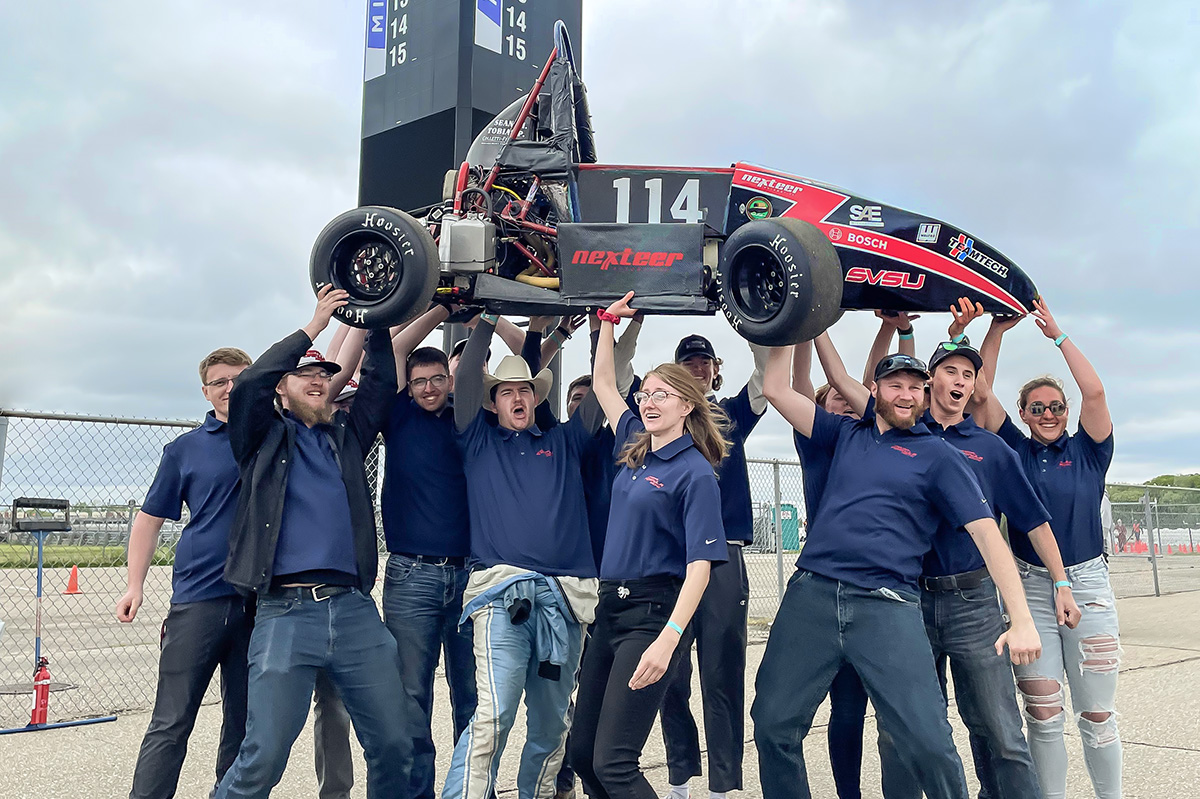June 1, 2023
SVSU race team delivers “most satisfying result” at Society of Automotive Engineers competition

The Cardinal Formula Racing Team at Saginaw Valley State University has built the fastest college race car in the world twice (2008, 2014) and has placed among the top 20 teams several times at the Formula Society of Automotive Engineers Collegiate Design Series. Still, Brooks Byam, SVSU professor of mechanical engineering, described this year’s finish as the “most satisfying result” in his 25 years of serving as the team’s faculty advisor.
“We have had alums go on to success as engineers on the NASCAR circuit and other competitive industries, and that determined spirit was on full display this year,” Byam said. “The team overcame header leaks and other challenges by managing their time, delegating tasks, making quick but effective decisions, and exhibiting phenomenal teamwork.”
Byam has earned a reputation in his field for guiding engineering students through adversity. He won the Carroll Smith Mentor’s Cup in 2013, given annually to one outstanding Society of Automotive Engineers faculty advisor.
“They made it through tech, tilt, nose and brakes with 55 minutes left before events closed,” he said.
The drama was just beginning for race team captain Sean McClary, an electrical engineering major from Bridgeport, and his teammates gathered at Michigan International Speedway.
“We were so late in the day, it happened to be raining,” McClary said, “and a race car with slicks in the rain doesn’t do too hot.” (Slicks are specialized racing tires.)
Still, the team managed to complete its 12 dynamic events that day. With 2 minutes to spare.
The next day, the team prepared to compete in the endurance portion of the competition, which is worth the most points toward a team’s total score.
“We qualified in the back of the pack for the endurance race,” McClary said. “This didn’t faze the team at all. We still knew that we built a fast car.
“When I got out on track, I pushed the car for every ounce of performance it could give. We were at the edge of traction at each turn, rocketing down the straights, and – put plainly – abusing our suspension and steering for all they’re worth. We were cooking. I passed at least 7 or 8 cars during the first leg.”
As if the team hadn’t encountered – and overcome – enough challenges, they had one more hurdle to clear.
When we pulled into the driver swap halfway through, the car immediately began spouting coolant,” McClary said. “This didn't stop our second driver, Lucas Leid. During the second leg, the traffic had mostly cleared, and he was able to put the pedal to the metal and bring the car home.”
McClary recalled an old adage in race car engineering: A well-engineered race car falls apart right after crossing the finish line.
“We did our best to live up to that saying,” he quipped. “Upon completing the race, the remainder of our coolant boiled off and the brakes seized from the heat. We had to push the car back to the paddock; that required half the team. Our performance in the endurance race shot us up from a would-be 70th place before the event."
Ultimately, the SVSU team finished 31st overall among the top 120 colleges and universities from around the globe who competed May 17-20. SVSU placed ahead of schools such as the University of Wisconsin-Madison (No. 55), Duke (No. 58), and Michigan Tech (No. 62).
SVSU students on the team demonstrated remarkable ingenuity and persistence during the competition. When the car failed its technical inspection, it was all hands on deck. They engaged in extensive troubleshooting and eventually realized that the problem was with a small pipe that connects the engine to the exhaust system.
After dropping the pipe into water, they found it had developed around 20 combined pinholes and stress cracks from wear and tear. They welded the pipe back together and reassembled the car just 90 minutes before the track closed for the day.
The tradition of success in the Cardinal Formula Racing team is easy to explain, McClary said.
“Because SVSU takes the race team so seriously, and because of the quality of the engineering program, combined with the dedication of the students.”
McClary is completing a summer internship in Texas with Peterbilt, a truck manufacturer, that he earned directly as a result of his experience with SVSU’s Cardinal Formula Racing program.
“Once you cross that barrier of taking what you learned in class and how to apply it, and you realize these are more than just equations and formulas, that I can make real things with them, when you get into the workforce and start interviewing, you can show employers you know how to turn knowledge into something useful. That’s when you start getting meaningful employment offers,” he said.
During the school year, McClary worked part-time for Nexteer Automotive in Saginaw, and he plans to return to that position in August. He is on track to graduate next May, but not before another season with the race team, one that perhaps includes a lot less race-day drama.
